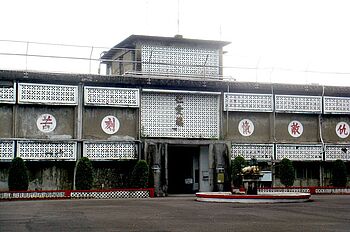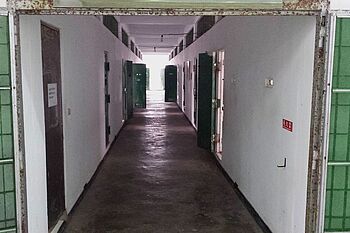Several memorials in Taiwan -- like this former military prison in Taipei -- commemorate the persecution carried out during the Kuomintang dictatorship. In addition to the many monuments, museums have also been established in former prisons, camps and historically significant buildings. The National Human Rights Museum has created an online database with 41 “Sites of Injustice.” Taiwan is thus demonstrating to the People's Republic of China how it too might try to address its violent past.
228 - Taipei Memorial

Credit: Ohne Autor / Creative Commons Attribution-Share Alike 3.0 Unported license
In Taiwan, “228” stands for February 28, 1947. On this day hundreds of Taiwan residents gathered in front of the government seat in Taipei to protest the colonialist conduct of the Chinese central government. The date plays an important role in Taiwan’s remembrance culture.
The spontaneous rally was a response to a police shooting of a passerby in a scuffle with a street vendor. When security forces opened fire on demonstrators in front of the government building, some of the protestors forced their way into a nearby radio station (photo) and made the events public. This led to angry demonstrations across the island.
The Chinese military governor ordered the violent suppression of the demonstrations, which led to the death of between 18,000 and 28,000 civilians. The massacre remained a taboo in Taiwan for decades. In 1995, President Lee Teng-hui of the former Kuomintang State Party apologized for the government’s actions. People who had been convicted were rehabilitated and a foundation paid over 200 million US dollars in compensation to more than 9,000 victims and their families. Memorials have been erected throughout the country to commemorate the victims. February 28 was declared a public holiday.
The former radio building has been home to a Taipei city memorial since 1997. The surrounding green area was named “228 Peace and Remembrance Park” and contains a monument. In 2007, the National Foundation for the Compensation of Victims began operating another museum in the Taiwanese capital to commemorate the events of 1947.
Links
Facebook page of the Taipei 228 Memorial Museum (Chinese)
Website of the National 228 Memorial Museum
After the Dictatorship. Instruments of Transitional Justice in Former Authoritarian Systems – An International Comparison
A project at the Department of Modern History at the University of Würzburg
Twitter: @afterdictatorship
Instagram: After the dictatorship
With financial support from the German Federal Ministry for Economic Cooperation and Development
Jing-Mei Memorial Park for the Victims of the White Terror

Credit: Reke / CC BY-SA
The military court of the Republic of China used to convene in the Jing-Mei district of the Taiwanese capital Taipei. The court played a key role in prosecuting opposition members in the 1970s and 1980s. During martial law, more than 16,000 people were tried for sedition or espionage. The courtroom and the adjacent prison (photo) are now a memorial.
The trial of what is known as the Formosa Incident was held at the military court. Civil rights activists associated with Formosa Magazine had called on people to attend a rally on Human Rights Day in December 1979. Police officers disguised as civilians began attacking the approaching military police. The government used this as an excuse to arrest all known members of the opposition. In 1980, the eight main defendants were sentenced to prison terms ranging from twelve years to life.
When martial law was lifted in 1987, the convicted prisoners were released. The military prison was closed four years later. At the suggestion of Vice President Lu Hsiu-lien Lu, who had been one of the defendants herself, a memorial was erected on the grounds in 2007. It has been expanded in recent years and is now part of the National Human Rights Museum, which was founded in 2011.
Visitors can visit the courtroom and the prison, both of which remain largely unchanged. In one room you can see the old tape recorders that were used by the Taiwanese State Security Service. In another room, replicas of bowls of food are displayed on a dozen tables where the prisoners took their meals. You can also visit a former laundry where prisoners had to work and the former prison yard. The expansive grounds, originally built as a military academy, are now a memorial park for the victims of the White Terror.
“Villa Oasis” Prison

Credit: Hubertus Knabe
Seemingly endless rows of green cell doors line the empty jail on the former “Green Island” prison. It was used by the Ministry of National Defense of Taiwan as a so-called reform and re-education prison from 1972 to 1987. The prison with the cynical name “Villa Oasis” is now part of a memorial park.
The cell building was erected after a prison revolt on Taiwan’s main island and surrounded by high walls and watchtowers. Political prisoners from various prisons were transferred here so that they could be more easily controlled. Among the prisoners were communists and alleged spies, as well as several human rights activists and representatives of the Taiwanese independence movement.
The building contains more than 200 cells across two floors in four separate wings that merge to form a star. Guards used to patrol at the intersection point of the building wings where they had a view of all the corridors. Prisoners were even watched when they went to the toilet, a knee-high tiled tub inside the cell. Life-size photos of inmates are displayed on the walls of a detention room to convey a feeling for the confined space. The former rubber cell and visitors' room are also open to the public. Separated by a pane of glass, prisoners were only allowed to speak to their relatives through a telephone.
The prison is almost unchanged. The re-education slogans are still on the large entrance gate: "Let us rejuvenate the nation through dedicated work!", "Let us support the government!", "Let us work together with absolute sincerity!” These kinds of slogans were also presented boldly in the four prison yards where prisoners were granted 20 to 30 minutes of fresh air twice a day. "Appreciate the law!", "Be sincere!" and "Obey the law!" are written in big Chinese characters on the walls.
A small exhibition in the entrance of the prison shows sketches of torture scenes depicting the brutality of the Kuomintang dictatorship. The prison is now part of a White Terror memorial park, which was established on the island in 2002. It includes the former “New Life” re-education camp as well as a monument listing the victims’ names.
New Life Correctional Center
Reconstructed camp barracks with prisoners
The prisoners lie or sit closely packed in barracks of the “New Life” Correctional Center. Its aim was to transform the prisoners into new people through hard labor and mental re-education. Today the camp is a museum, which even includes replicas of the prisoners.
The memorial is located on “Green Island,” a small island about 30 kilometers off the east coast of Taiwan. The rocky island in the middle of the Pacific Ocean had previously served as a penal colony for the Japanese. The Kuomintang government incarcerated its political prisoners here for decades.
The camp was located in a bay closed off by cliffs. The natural conditions alone made it nearly impossible to escape. Thousands of people were imprisoned here from 1951 to 1965. Up to 2,000 prisoners, divided into 12 units, had to perform forced labor in the camp. Some worked as lumberjacks, others had to break rocks in the surf to build pigsties, grain stores and tool sheds. Others were engaged in growing vegetables or raising pigs.
The harsh everyday conditions in the camp were accompanied by systematic political indoctrination. Words such as “decency,” “justice,” “righteousness” and “honor” were written in huge letters on the mountain slopes. During regular mandatory “lessons,” prisoners were subjected to outright brainwashing, a method that continues to be used in China today. If a prisoner refused to be reconditioned, he was sent to another island or, like 14 prisoners in 1953, was executed.
With the exception of a weathered watchtower, an old prison building and the remains of the prison kitchen, little remains of the original buildings. The entrance gate through which the prisoners entered the camp was rebuilt, as were the accommodations and the exit gate through which they were released after being declared purified.
An elaborate exhibition in the reconstructed barracks tells the history of the camp. Dioramas and life-size replicas show how prisoners broke the rocks, marched in rows of two and were subjected to re-education on small wooden benches. A barrack with two-story bunks and figures of prisoners was also completely rebuilt.
